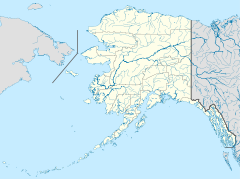- Jesse Lee Home for Children
-
Jesse Lee Home for Children
Location: Swetmann Ave., Seward, Alaska Coordinates: 60°7′37″N 149°26′36″W / 60.12694°N 149.44333°WCoordinates: 60°7′37″N 149°26′36″W / 60.12694°N 149.44333°W Area: 2.7 acres (1.1 ha) Built: 1926 Architect: Stanley Shaw; John Holm Governing body: Private NRHP Reference#: 95001146[1] Added to NRHP: September 29, 1995 The Jesse Lee Home for Children is a former orphanage in Seward, Alaska, United States. The orphanage was operated by the United Methodist Church from its opening in 1926 until the building suffered damage from a 1964 earthquake and operations were relocated to a new building in Anchorage.
History
Prior to 1926, the Methodist Church operated orphanages in Nome and Unalaska. In the late 1910s and early 1920s, the Spanish flu pandemic was particularly deadly in remote native villages, leaving more orphaned children.[2] The old missions were overfilled, in disrepair, and transportation of supplies and children to these remote locations was unreliable and expensive. Seward was selected as a new location because at that point in time, it was Alaska's largest port and transportation point. Transportation costs would be lower due to regularly scheduled routes directly from Seattle.[3]
Child residents were mainly natives from the Aleutian Islands (Aleut) and Seward Peninsula (Eskimo). In the first year after the school opened in 1926, resident Benny Benson won a competition to design the state flag. Benson, who was moved from the previous home in Unalaska, was from the village of Chignik. He was a 13-year-old student who won the competition out of over 700 entries. On July 9, 1927, the new flag was raised for the first time at the Jesse Lee Home, and the date is still commemorated in the state as Flag Day.[3][4]
The site consisted of three main buildings connected by arcades and several smaller buildings. Original construction included two dormitories, Jewel Guard Hall and Goode Hall. The Balto Building was added between the two dormitories in 1936 and provided dining space and several kitchens. In additional to boy's dormitories, Jewel Guard Hall held a shop, vocational classrooms, a darkroom, classrooms, library, and gymnasium. Goode Hall served as the girl's dormitory and administrative offices. Additional buildings on the property included a superintendent's house, barn, schoolhouse, residence, garage, and cold storage.[5] During World War II, the residents were moved to other locations. The primary buildings were painted camouflage and a temporary Fort Raymond Army Base occupied part of the home's property.[2]
The home reopened after the war but rather than attending class there, the students attended nearby Bayview Elementary and Seward High School, and government-provided food replaced the gardens and livestock. The number of residents declined from its high of 120 to between 30 and 40.[5]
An earthquake in 1964 severely affected Seward and much of the complex. Goode Hall, the largest of the buildings, was heavily damaged and required demolition. The church opened a new orphanage in Anchorage and the Seward home was closed. In 1966 the property was sold to the city, then to a private owner before being acquired by the city again.[3]
References
- ^ "National Register Information System". National Register of Historic Places. National Park Service. 2009-03-13. http://nrhp.focus.nps.gov/natreg/docs/All_Data.html.
- ^ a b Jesse Lee Home - Historic Structure Report, ECI/Hyer, Inc. Architecture Interiors Development, May 2003
- ^ a b c "The Jesse Lee Home for Children". Seward Historic Preservation Commission. http://www.cityofseward.net/hpc/historic_properties/jesse_lee_home.shtml.htm. Retrieved 4 December 2009.
- ^ "Benny Benson". Friends of the Jesse Lee Home. http://www.jesseleehome.net/benson.html. Retrieved 4 December 2009.
- ^ a b "National Register of Historic Places Registration Form". National Park Service. http://pdfhost.focus.nps.gov/docs/NRHP/Text/95001146.pdf. Retrieved 10 December 2009.
External links
U.S. National Register of Historic Places Topics Lists by states Alabama • Alaska • Arizona • Arkansas • California • Colorado • Connecticut • Delaware • Florida • Georgia • Hawaii • Idaho • Illinois • Indiana • Iowa • Kansas • Kentucky • Louisiana • Maine • Maryland • Massachusetts • Michigan • Minnesota • Mississippi • Missouri • Montana • Nebraska • Nevada • New Hampshire • New Jersey • New Mexico • New York • North Carolina • North Dakota • Ohio • Oklahoma • Oregon • Pennsylvania • Rhode Island • South Carolina • South Dakota • Tennessee • Texas • Utah • Vermont • Virginia • Washington • West Virginia • Wisconsin • WyomingLists by territories Lists by associated states Other  Category:National Register of Historic Places •
Category:National Register of Historic Places •  Portal:National Register of Historic Places
Portal:National Register of Historic PlacesSeward, Alaska Historic sites Ballaine House · Brown & Hawkins Store · Lowell Creek Diversion Tunnel · Government Cable Office · Hoben Park · Jesse Lee Home for Children · St. Peter's Episcopal Church · Seward Depot · Swetmann House · Van Gilder HotelGeography Transporation Other Mount Marathon Race · Alaska SeaLife Center · Alaska Vocational Technical Center · Spring Creek Correctional CenterCategories:- Buildings and structures completed in 1926
- Buildings and structures in Kenai Peninsula Borough, Alaska
- Orphanages in the United States
- Properties of religious function on the National Register of Historic Places in Alaska
- 1926 establishments
Wikimedia Foundation. 2010.

